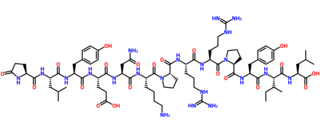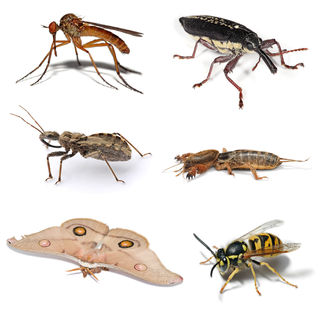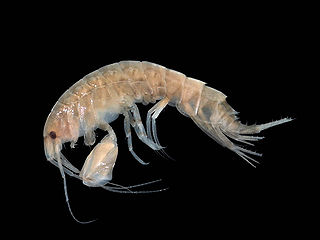Allatostatins are neuropeptide hormones in insects and crustacea. They have a twofold function: they both inhibit the generation of juvenile hormone and reduce their food intake. They are therefore putative targets for insecticide research.
The C-terminus is the end of an amino acid chain, terminated by a free carboxyl group (-COOH). When the protein is translated from messenger RNA, it is created from N-terminus to C-terminus. The convention for writing peptide sequences is to put the C-terminal end on the right and write the sequence from N- to C-terminus.

β-Endorphin is an endogenous opioid neuropeptide and peptide hormone that is produced in certain neurons within the central nervous system and peripheral nervous system. It is one of three endorphins that are produced in humans, the others of which include α-endorphin and γ-endorphin.

Gastrin-releasing peptide, also known as GRP, is a neuropeptide, a regulatory molecule that has been implicated in a number of physiological and pathophysiological processes. Most notably, GRP stimulates the release of gastrin from the G cells of the stomach.

Motilin is a 22-amino acid polypeptide hormone in the motilin family that, in humans, is encoded by the MLN gene.

Neurotensin is a 13 amino acid neuropeptide that is implicated in the regulation of luteinizing hormone and prolactin release and has significant interaction with the dopaminergic system. Neurotensin was first isolated from extracts of bovine hypothalamus based on its ability to cause a visible vasodilation in the exposed cutaneous regions of anesthetized rats.
Endomorphins are considered to be natural opioid neurotransmitters central to pain relief. The two known endomorphins, endomorphin-1 and endomorphin-2, are tetrapeptides, consisting of Tyr-Pro-Trp-Phe and Tyr-Pro-Phe-Phe amino acid sequences respectively. These sequences fold into tertiary structures with high specificity and affinity for the μ-opioid receptor, binding it exclusively and strongly. Bound μ-opioid receptors typically induce inhibitory effects on neuronal activity. Endomorphin-like immunoreactivity exists within the central and peripheral nervous systems, where endomorphin-1 appears to be concentrated in the brain and upper brainstem, and endomorphin-2 in the spinal cord and lower brainstem. Because endomorphins activate the μ-opioid receptor, which is the target receptor of morphine and its derivatives, endomorphins possess significant potential as analgesics with reduced side effects and risk of addiction.
Corticotropin-like intermediate [lobe] peptide (CLIP), also known as adrenocorticotropic hormone fragment 18-39, is a naturally occurring, endogenous neuropeptide with a docosapeptide structure and the amino acid sequence Arg-Pro-Val-Lys-Val-Tyr-Pro-Asn-Gly-Ala-Glu-Asp-Glu-Ser-Ala-Glu-Ala-Phe-Pro-Leu-Glu-Phe. CLIP is generated as a proteolyic cleavage product of adrenocorticotropic hormone (ACTH), which in turn is a cleavage product of proopiomelanocortin (POMC). Its physiological role has been investigated in various tissues, specifically in the central nervous system.

Met-enkephalin, also known as metenkefalin (INN), sometimes referred to as opioid growth factor (OGF), is a naturally occurring, endogenous opioid peptide that has opioid effects of a relatively short duration. It is one of the two forms of enkephalin, the other being leu-enkephalin. The enkephalins are considered to be the primary endogenous ligands of the δ-opioid receptor, due to their high potency and selectivity for the site over the other endogenous opioids.

Dynorphin A is a form of dynorphin and an endogenous opioid peptide with the amino acid sequence: Tyr-Gly-Gly-Phe-Leu-Arg-Arg-Ile-Arg-Pro-Lys-Leu-Lys.

Eledoisin is an undecapeptide of mollusk origin, belonging to the tachykinin family of neuropeptides.
Crustacean cardioactive peptide (CCAP) is a highly conserved, amidated cyclic nonapeptide with the primary structure PFCNAFTGC-NH2 (ProPheCysAsnAlaPheTyrGlyCys-NH2) and a disulfide bridge between Cys3 and Cys9. It is found in crustaceans and insects where it behaves as a cardioaccelerator, neuropeptide transmitter for other areas of the nervous system and a hormone. CCAP was first isolated from the pericardial organs of the shore crab Carcinus maenas, where it has a role in regulating heartbeat. It was assumed that this was the peptide's main function and its name reflects this.
Corazonin is a highly conserved neuropeptide found in many insects, in particular locusts and cockroaches.
Bursicon is an insect hormone which mediates tanning in the cuticle of adult flies.
The gastrin family of proteins is defined by the peptide hormones gastrin and cholecystokinin. Gastrin and cholecystokinin (CCK) are structurally and functionally related peptide hormones that serve as regulators of various digestive processes and feeding behaviors. Additional structurally related members of this family include the amphibian caerulein skin peptide, the cockroach leukosulphakinin I and II (LSK) peptides, Drosophila melanogaster putative CCK-homologs Drosulphakinins I and II, cionin, a chicken gastrin/cholecystokinin-like peptide and cionin, a neuropeptide from the protochordate Ciona intestinalis.

Spinorphin is an endogenous, non-classical opioid peptide of the hemorphin family first isolated from the bovine spinal cord (hence the prefix spin-) and acts as a regulator of the enkephalinases, a class of enzymes that break down endogenous the enkephalin peptides. It does so by inhibiting the enzymes aminopeptidase N (APN), dipeptidyl peptidase III (DPP3), angiotensin-converting enzyme (ACE), and neutral endopeptidase (NEP). Spinorphin is a heptapeptide and has the amino acid sequence Leu-Val-Val-Tyr-Pro-Trp-Thr (LVVYPWT). It has been observed to possess antinociceptive, antiallodynic, and anti-inflammatory properties. The mechanism of action of spinorphin has not been fully elucidated (i.e., how it acts to inhibit the enkephalinases), but it has been found to act as an antagonist of the P2X3 receptor, and as a weak partial agonist/antagonist of the FP1 receptor.
Modified GRF (1-29) often abbreviated as mod GRF (1-29), originally known as tetrasubstitued GRF (1-29), is a term used to identify a 29 amino acid peptide analogue of growth-hormone-releasing hormone (GHRH), a releasing hormone of growth hormone (GH). It is a modified version of the shortest fully functional fragment of GHRH, often referred to as growth hormone releasing factor (1-29), and also known by its standardized name, sermorelin.
CNMamide (CNMa) is a cyclic neuropeptide identified by computational analysis of Drosophila melanogaster protein sequences and named after its C-terminal ending motif. A gene encoding CNMa was found in most arthropods and comparison among the precursor sequences of several representative species revealed high conservation, particularly in the region of the predicted mature peptide. Two conserved cysteine residues enveloping four amino acids form a disulfide bond and were shown to be important for binding of the peptide to its receptor. Expression of CNMa was confirmed in the larval and adult brain of D. melanogaster but the function of the peptide has not been elucidated yet.

Octopamine is an organic chemical closely related to norepinephrine, and synthesized biologically by a homologous pathway. Its name derives from the fact that it was first identified in the salivary glands of the octopus.


















